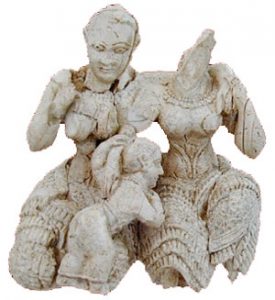
Mycenaeans: Two women and a child (Mycenae, ca. 1500 BC)
Mycenaeans
By around 1600 BC, the Greeks had gotten completely mixed with the earlier Lerna people, and began to move on to bigger things. First, they started to get to know the other people living around the Mediterranean Sea, especially the Phoenicians (foy-NEE-shans), the Cretans, and the Egyptians.
Mercenary soldiers and textiles
They seem to have started to take jobs as soldiers for the Egyptians, who paid them in gold. Mycenaeans also built big weaving factories, staffed by enslaved women (often prisoners of war), who wove fancy wool and linen fabrics for traders to sell.

Mask of Agamemnon, from Mycenae, Greece (1500 BC). Now in Athens
Gold cups and swords
And they started to buy things from the Phoenicians (or Canaanites) with their gold. Greek graves from this time excavated at Mycenae (my-SEEN-ay) have a lot of gold cups and jewelry and beautiful swords in them, which are now in the National Archaeological Museum in Athens, Greece. The Greeks of this time are sometimes called the Mycenaeans (my-sin-AY-ans) after this site.

The Lion Gate, Mycenae (ca. 1500 BC)
Kings and palaces
As they got to know these other people, the Greeks began to copy their ways of doing things. The Greeks started to have kings instead of village headmen.
These kings had palaces to live in and collected taxes which they stored in big storerooms. The palaces had big stone walls around them. The stones were so big that later Greeks thought the walls must have been built by giants, whom they called Cyclops.
Linear B writing
Some Greeks learned to write, in a sort of hieroglyphics called Linear B, so that they could keep records of what taxes had been collected. The kings made their people build paved roads.
In addition to maybe working as soldiers for other countries, the Greeks seem to have sailed around the Mediterranean Sea and the Black Sea picking fights with people on their own, and taking their gold, and probably also taking the people they met as slaves.
The Trojan War
One of these raids, around 1250 BC, may have been to attack the city of Troy, in northern Turkey. Stories about the Trojan War (the war with Troy) were passed down for hundreds of years by singers until they were written down by the poet Homer around 700 BC.
The collapse of the Mycenaeans
Homer says that when the Greek soldiers came back from the Trojan War they found that Greece was in very bad shape, with a lot of robbers and crime. There may be some truth in this, because archaeology shows that around 1200BC most of the Greek palaces were destroyed, including the one at Mycenae.
We don’t know why this happened, but many people think that there was a general economic depression in the other countries of the Eastern Mediterranean and West Asia around this time, especially in Egypt and in the Hittite kingdom. A lot of people seem to have fallen on hard times. Maybe the Greeks found themselves out of work.
Learn by doing: make a “silver” mask out of aluminum foil
More about the Greek Dark Ages
Bibliography and further reading about Late Bronze Age Greece:
The Archaeology of Greece: An Introduction, by William R. Biers (1996). Biers writes very clearly and has a lot of good pictures.
The Aegean Bronze Age (Cambridge World Archaeology) by Oliver Dickinson, Norman Yoffee (Editor) (1994)
The Mycenaeans (Ancient Peoples and Places), by William Taylour (revised edition 1990).